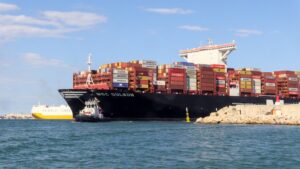
During this first part of the year, the cost of maritime transport is characterised by fluctuation due to the geopolitical situation and economic uncertainty.
The Index stands at 4,866.15 points, accumulating a growth of 386.6% since the beginning of the series in 2018
The Western Mediterranean area decreases by 1.96% and the Far East decreases by 0.1%, the latter accumulating three consecutive months of decline
Congestion in Chinese ports falls, increases in North American ports and remains the same in European ports
The Valencia Container Freight Index (VCFI) for the month of July has risen again after the fall suffered the previous month, following the trend of these first months of 2022 where increases and decreases in the Index have been interchanged. A period in which the activity of the maritime sector is being conditioned by the high levels of uncertainty in the world economic situation and the geopolitical situation. Thus, in the month of July the VCFI stood at 4,866.15 points which represents an increase of 2.5% over the previous month and an accumulated growth since the beginning of the series in January 2018 of 386.6%. This increase in the value of the index is unevenly distributed over the time horizon of the data, as well as in the thirteen geographical areas that make up the index. In fact, the Western Mediterranean area shows an increase of 1.96%, while the Far East showed a decrease of 0.1%.
As for the energy markets, the average price of a barrel of Brent crude oil in July was $111.93, compared with $122.71 in June, a decrease of 8.78%. Similarly, marine fuels in general have fluctuated downwards. For this purpose, the price of bunkering (refuelling of ships at sea) in the 20 main ports of the world has been considered, according to the data provided by Ship&Bunker. Thus, the price of VLSFO (Very Low Sulphur Fuel Oil) has gone from 1077.50$ in June to 914.50$ in July, representing a drop of 15.1%.
In relation to capacity on offer, data from the consultancy Alphaliner show a drop in idle fleet levels compared to the previous month. As a result, 63 vessels were idle in mid-July, totalling 218,222 TEUs, representing 0.9% of the total active fleet.
As far as congestion levels are concerned, the clear downward trend of previous months continues, without yet reaching pre-pandemic average levels. World port congestion was slightly reduced in the last weeks of July with improvements in China, although delays in North American ports – where protests by truck, rail and port workers are pressing for their respective causes – have worsened. In Europe, there is no significant change in the situation. Thus, North American ports remain the most critical congestion hotspot, with 39% of the global bottleneck, while North Asia’s share decreased from 24% to 20%, while Northern European and Mediterranean ports increased marginally from 19% to 20%. The other regions remain stable with no change in the congestion situation.
With regard to the different areas which make up the VCFI, the increase in the East Coast Africa area (9.87%) due to the floods which have hit the Port of Durban stands out. Increases were also noted in the areas of Central America and the Caribbean and the USA and Canada. At the same time, significant falls in freight rates were seen in Africa West Coast (-6.41%), the Middle East and the Indian Subcontinent.
VCFI Western Mediterranean
As for the Western Mediterranean sub-index, a rise is observed with respect to the previous month of 1.96%, standing at 2,487.88 points, and accumulating a growth of 148.95% since the beginning of the series in 2018.
As in the previous month, the effect of the decision taken by the Algerian government on 9 June to suspend the Treaty of Friendship, Good Neighbourliness and Cooperation signed with Spain two decades ago stands out, giving rise to a retraction in trade flows with that country, as well as a generalised port blockade. However, it is worth mentioning that recently, on 29 July, the Algerian authorities decided to backtrack and re-establish the situation, so it is hoped that there may be changes for the next reading of the VCFI.
VCFI Far East
Regarding the Far East area, a decrease of 0.1% is perceived, standing at 3,749.90 points and accumulating an increase of 274.99% with respect to the beginning of the series in January 2018.
In this line, a decrease in Valenciaport’s export flows with China, its main trading partner, continues to stand out, although it is expected that the situation will be reversed in the coming weeks, given the return to normality of Chinese ports after the cessation of the 0-COVID policies, as well as the drops in freight rates on the major routes in which this sub-index is included.

